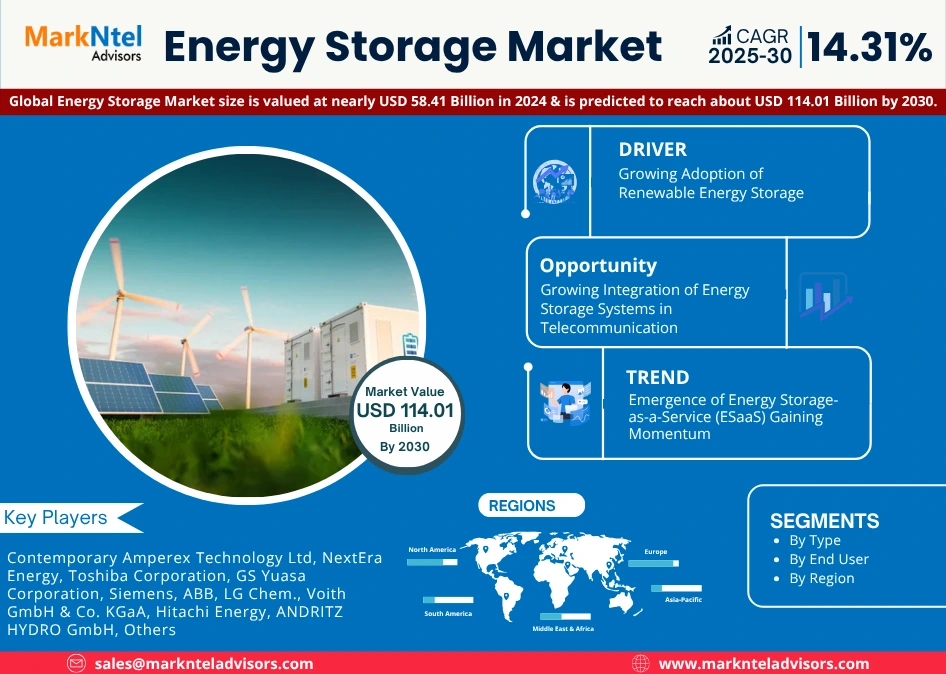
Global Energy Storage Market Research Report: Forecast (2025-2030)
Energy Storage Market- By Type (Battery [Lithium-ion Batteries, Lead-acid Batteries, Redox Flow Batteries], Pumped Storage Hydropower, Compressed Air Energy Storage, Gravity-based ...Energy Storage, Liquid Air Energy Storage [LAES], Flywheel Energy Storage [FES]), By End User (Residential, Commercial, Utilities), By Region (North America, South America, Europe, The Middle East & Africa, Asia-Pacific), and others Read more
- Energy
- Mar 2025
- Pages 232
- Report Format: PDF, Excel, PPT
Market Definition
Energy storage is the process of accumulating energy in specific devices or systems for future use, allowing companies and industries to conserve energy and utilize it when energy demand rises. In this way, energy storage ensures a steady supply-demand equilibrium for consumers, avoiding issues like unreliable electricity and abrupt price spikes. It stores green energies like solar, wind, hydro, and others. There are various types of energy storage, including mechanical, electrochemical, thermal, electrical, and hydrogen-based storage.
Market Insights & Analysis: Global Energy Storage Market (2025-30):
The Global Energy Storage Market size is valued at nearly USD 58.41 Billion in 2024 & is predicted to reach about USD 114.01 Billion by 2030. Along with this, the market is also estimated to grow at a CAGR of around 14.31% during the forecast period, i.e., 2025-30. The market's growth is driven by the increasing support from governments for the adoption of robust & resilient global energy grids. The government initiatives in the energy storage sector are on the rise, underpinned by a surge in policies & regulations. These measures are designed to facilitate the transition from fossil fuels to renewable energy sources, a critical strategy for mitigating climate change & curbing greenhouse gas emissions.
| Report Coverage | Details |
|---|---|
| Historical Years | 2020-23 |
|
Base Years
|
2024
|
|
Forecast Years
|
2025-30
|
| Market Value in 2024 | USD 58.41 Billion |
| Market Value by 2030 | USD 114.01 Billion |
| CAGR (2025-30) | 14.31% |
| Leading Region | Asia-Pacific |
| Top Key Players | Contemporary Amperex Technology Ltd, NextEra Energy, Toshiba Corporation, GS Yuasa Corporation, Siemens, ABB, LG Chem., Voith GmbH & Co. KGaA, Hitachi Energy, Mitsubishi Electric Corporation, Tesla, Samsung SDI, UniEnergy Technologies, LLC, General Electric, ANDRITZ HYDRO GmbH, Others |
| Key Report Highlights |
|
*Boost strategic growth with in-depth market analysis - Get a free sample preview today!
Nonetheless, renewable energy sources, such as solar and wind, are known for their intermittent power generation, dependent on factors like sunlight & wind patterns. This intermittency poses substantial challenges to grid stability & reliability. Energy storage systems have emerged as a pivotal solution to address this challenge, effectively integrating renewable energy storage systems into the grid infrastructure. Consequently, countries like the US, Germany, and India, among others, are instituting policies & regulations to incentivize and promote the widespread deployment of energy storage technologies. Due to these policies and regulations by countries, there is a surging investment in the sector by companies like LG Chem, ABB, and Samsung, which are expected to make energy storage systems more affordable & accessible.

Moreover, energy storage solutions such as pumped hydro and batteries are being increasingly integrated into the electricity grid to facilitate various functions, including the seamless integration of renewable energy sources, peak demand management, and grid modernization. These systems can effectively store surplus energy during periods of abundance and release it when renewable energy generation is less. By deploying energy storage, governments could facilitate the integration of renewable energy sources and achieve their clean energy and climate goals. Thus, countries like Spain, China, Ireland, etc., are initiating to integrate energy storage systems in their electricity grid. For instance:
- In 2023, European energy conglomerates, research institutions, and universities have initiated a four-year endeavor aimed at accelerating the swift adoption of renewable energy sources. This project focuses on the advanced integration of cutting-edge energy storage technologies, intending to enable energy companies to fulfill their commitment to achieving a 55% reduction in carbon emissions across the economy by 2030. The project is slated to continue its efforts until the conclusion of 2026.
These developments in energy storage and the rising integration of energy storage systems in electricity would scale up the Global Energy Storage Market growth in the prediction period.
Global Energy Storage Market Driver:
Growing Adoption of Renewable Energy Storage – The Energy Storage Market has been significantly propelled by the expanding adoption of renewable energy sources, notably solar & wind, in recent years. The intermittent nature of these renewable sources necessitates the usage of energy storage systems to capture surplus energy during periods of high generation & release it when demand peaks, ensuring a more dependable & consistent supply of renewable energy. The growing prevalence of renewable energy sources, marked by their intermittency & variability, has resulted in a supplemented need for energy storage solutions.
Moreover, the integration of large-scale renewable energy into power grids has introduced challenges related to grid stability, voltage control, and frequency regulation. Energy storage systems offer a viable solution by allowing grid operators to mitigate fluctuations in power generation and consumption, thereby enhancing grid stability and facilitating the seamless integration of renewables. As Europe, the Middle East, and the Asia-Pacific region embark on ambitious renewable energy projects to meet their clean energy targets, the demand for energy storage systems is expected to witness a notable upswing in the forecast period.
Global Energy Storage Market Opportunity:
Growing Integration of Energy Storage Systems in Telecommunication – The increasing integration of energy storage systems within the telecommunications industry is poised to drive market growth shortly. Telecommunication networks rely on a continuous power supply for seamless operation, making energy storage systems, such as batteries, invaluable for providing backup power during grid disruptions. This integration not only enhances network resilience but also reduces downtime, ensuring uninterrupted communication services during power outages. Moreover, energy storage systems entail lower maintenance requirements than traditional backup sources like diesel generators, resulting in cost savings.
In addition, the telecom sector's growing emphasis on economic sustainability is catalyzing the adoption of energy storage systems. By incorporating these systems, particularly batteries, telecom companies can reduce greenhouse gas emissions, mitigate their environmental footprint, and contribute to a more sustainable energy transition. For instance:
- In 2023, the Finnish telecom company Elisa secured a government investment of approximately USD 4.16 million to implement Distributed Energy Storage (DES) solutions across its network, with an expected capacity of 150 megawatt-hours.
This dual benefit of cost reduction & heightened environmental responsibility is expected to foster the widespread adoption of energy storage systems in the coming years.
Global Energy Storage Market Trend:
Emergence of Energy Storage-as-a-Service (ESaaS) Gaining Momentum – In the modern grid, energy storage is predicting a heightened role, driven by a spectrum of emerging business models. Among these, 'Energy Storage as a Service' (ESaaS) is gaining prominence, particularly within the commercial & industrial sectors. This model involves delivering energy storage systems to customers through service agreements, eliminating the need for outright system purchases. ESaaS offers customers access to the benefits of energy storage without the initial financial commitment and the intricacies associated with ownership.
This approach provides a versatile solution that addresses a range of needs, including peak demand management, load shifting, grid services, backup power, and the seamless integration of renewable energy sources. These advantages have been instrumental in accelerating the adoption of energy storage-as-a-service within the commercial and industrial sectors. For instance:
- In 2022, Nestle Nescafe partnered with Schneider Electrics to deploy its energy storage service EcoStruxure for improving uptime reliability, greater visibility, etc.
The increasing prevalence of ESaaS in the commercial & industrial sectors would propel the Energy Storage Market growth in the forthcoming period.
Global Energy Storage Market (2025-30): Segmentation Analysis
The Global Energy Storage Market study by MarkNtel Advisors evaluates & highlights the major trends & influencing factors in each segment and includes predictions for the period 2025–2030 at the global levels. In accordance to the analysis, the market has been further classified as:
Based on Type:
- Battery
- Pumped Storage Hydropower
- Compressed-air Energy Storage (CAES)
- Gravity-based Energy Storage
- Liquid Air Energy Storage (LAES)
- Flywheel Energy Storage (FES)
Pumped Storage Hydropower is poised to dominate a significant portion of the Energy Storage Market in the near future. The surge in electricity demand originating from renewable sources across diverse sectors, including residential, commercial, government, transport, and industrial, has been a key driver behind the historical growth of pumped storage hydropower. Moreover, concerns related to energy security, including potential supply disruptions & price volatility linked to foreign fossil fuel dependence, have heightened the urgency for domestically sourced and reliable energy supplies.
Renewable energy, being primarily of domestic origin, offers a more secure energy supply. Consequently, governments worldwide, including India, the UK, and the US, have established ambitious targets for renewable energy deployment, aiming to achieve zero emissions & mitigate the impacts of climate change. This intensified demand for electricity generated from renewable sources is expected to bolster the market's prominence in the years to come.
Based on End User:
- Residential
- Commercial & Industrial
- Utilities
The Commercial & Industrial segment is poised for notable expansion in the forecast years. Industrial operations typically demand substantial power, and any disruption or variation in electricity supply can translate into significant financial setbacks. Energy storage systems come to the fore in providing grid stability, offering benefits like frequency regulation & voltage support to ensure a consistent and high-quality power supply. This aspect is particularly critical for industries housing sensitive equipment & intricate processes, including manufacturing facilities, data centers, and pharmaceutical plants.
Consequently, the industrial sector is increasingly pivoting toward the adoption of renewable energy sources, such as solar and wind. This strategic shift further underscores the growing significance of energy storage systems in the coming years.
Global Energy Storage Market (2025-30): Regional Projection
Geographically, the Global Energy Storage Market expands across:
- North America
- South America
- Europe
- The Middle East & Africa
- Asia-Pacific
The Asia-Pacific region is poised for substantial growth in the Energy Storage Market in the coming years. This growth is primarily driven by rapid urbanization, population expansion, and increasing industrialization, all of which contribute to a surging demand for energy. There has been a notable rise in the deployment of renewable energy sources in the region, aligning with the transition toward cleaner energy generation. According to the International Energy Agency (IEA), India witnessed an 8% increase in power demand in 2022 compared to the previous year, exemplifying the heightened energy requirements.
These escalating energy demands have spurred energy transitions in countries like China, India, Indonesia, and others. As the shift towards cleaner and more sustainable energy sources gains momentum, along with efforts to reduce carbon emissions, the Asia-Pacific region is set to witness a surge in renewable energy installations, consequently driving the demand for the Energy Storage Market in the forecast period.
Global Energy Storage Industry Recent Development:
- 2025: Contemporary Amperex Technology Co., Limited (CATL) introduces sodium-ion batteries. This development marks a strategic expansion to provide sustainable energy alternatives. Sodium-ion technology offers a promising shift from Lithium-ion solutions, aiming to diversify and enhance energy storage systems.
- 2024: NextEra Energy Resources LLC, a subsidiary of NextEra Energy Inc. and Entergy announced a joint development agreement that will accelerate the development of up to 4.5 gigawatts (GW) of new solar generation and energy storage projects. The agreement represents significant progress toward Entergy's growing portfolio of renewable generation.
Gain a Competitive Edge with Our Global Energy Storage Market Report
- Global Energy Storage Market Report by MarkNtel Advisors provides a detailed & thorough analysis of market size, share, growth rate, competitive landscape, and key players. This comprehensive analysis helps businesses gain a holistic understanding of the market dynamics & make informed decisions.
- This report also highlights current market trends & future projections, allowing businesses to identify emerging opportunities & potential challenges. By understanding market forecasts, companies can align their strategies & stay ahead of the competition.
- Global Energy Storage Industry Report aids in assessing & mitigating risks associated with entering or operating in the market. By understanding market dynamics, regulatory frameworks, and potential challenges, businesses can develop strategies to minimize risks & optimize their operations.
*Reports Delivery Format - Market research studies from MarkNtel Advisors are offered in PDF, Excel and PowerPoint formats. Within 24 hours of the payment being successfully received, the report will be sent to your email address.
Frequently Asked Questions
- Market Segmentation
- Introduction
- Product Definition
- Research Process
- Assumptions
- Executive Summary
- Global Energy Industry Outlook, 2025
- Generation, By Source
- Renewable
- Hydro
- Solar
- Wind
- Biomass Energy
- Geothermal
- Non-renewables
- Coal
- Natural Gas
- Oil
- Nuclear Energy
- Renewable
- Generation, By Region
- North America
- South America
- Europe
- The Middle East & Africa
- Asia-Pacific
- Government Initiatives, By Countries
- The US
- Canada
- Brazil
- The UK
- Germany
- Spain
- Saudi Arabia
- The UAE
- South Africa
- China
- India
- Others
- Generation, By Source
- Global Energy Storage Market, Startup, Investment, and Ecosystem
- Entrepreneurial Activity
- Year on Year Funding Received
- Funding Received by Top Companies
- Key Investors Active in the Market
- Series-wise Funding Received
- Seed Funding
- Angel Investing
- Venture Capitalists (VC) Funding
- Others
- Global Energy Storage Market Pricing Analysis
- Global Energy Storage Market Trends & Developments
- Global Energy Storage Market Dynamics
- Drivers
- Challenges
- Global Energy Storage Market Regulations & Policies
- Global Energy Storage Hotspot & Opportunities
- Global Energy Storage Market Outlook, 2020-2030F
- Market Size & Analysis
- By Revenues (USD Billion)
- Market Size & Analysis
- By Type
- Battery- Market Size & Forecast 2020-2030, USD Billion
- Lithium-ion Batteries- Market Size & Forecast 2020-2030, USD Billion
- Lead-acid Batteries- Market Size & Forecast 2020-2030, USD Billion
- Redox Flow Batteries- Market Size & Forecast 2020-2030, USD Billion
- Pumped Storage Hydropower - Market Size & Forecast 2020-2030, USD Billion
- Compressed Air Energy Storage - Market Size & Forecast 2020-2030, USD Billion
- Gravity-based Energy Storage - Market Size & Forecast 2020-2030, USD Billion
- Liquid Air Energy Storage (LAES) - Market Size & Forecast 2020-2030, USD Billion
- Flywheel Energy Storage (FES) - Market Size & Forecast 2020-2030, USD Billion
- Battery- Market Size & Forecast 2020-2030, USD Billion
- By End User
- Residential- Market Size & Forecast 2020-2030, USD Billion
- Commercial - Market Size & Forecast 2020-2030, USD Billion
- Utilities- Market Size & Forecast 2020-2030, USD Billion
- By Region
- North America
- South America
- Europe
- The Middle East & Africa
- Asia-Pacific
- By Competition
- Competition Characteristics
- Market Share Analysis
- By Type
- Market Size & Analysis
- North America Energy Storage Market Outlook, 2020-2030F
- Market Size & Analysis
- By Revenues (USD Billion)
- Market Share & Analysis
- By Type- Market Size & Forecast 2020-2030, USD Billion
- By End User- Market Size & Forecast 2020-2030, USD Billion
- By Country
- The US
- Canada
- Mexico
- The US Energy Storage Market Outlook, 2020-2030F
- Market Size & Analysis
- By Revenues (USD Billion)
- Market Size & Analysis
- Canada Energy Storage Market Outlook, 2020-2030F
- Market Size & Analysis
- By Revenues (USD Billion)
- Market Size & Analysis
- Mexico Energy Storage Market Outlook, 2020-2030F
- Market Size & Analysis
- By Revenues (USD Billion)
- Market Size & Analysis
- Market Size & Analysis
- South America Energy Storage Market Outlook, 2020-2030F
- Market Size & Analysis
- By Revenues (USD Billion)
- Market Share & Analysis
- By Type- Market Size & Forecast 2020-2030, USD Billion
- By End User Market Size & Forecast 2020-2030, USD Billion
- By Country
- Brazil
- Argentina
- Rest of South America
- Brazil Energy Storage Market Outlook, 2020-2030F
- Market Size & Analysis
- By Revenues (USD Billion)
- Market Size & Analysis
- Argentina Energy Storage Market Outlook, 2020-2030F
- Market Size & Analysis
- By Revenues (USD Billion)
- Market Size & Analysis
- Market Size & Analysis
- Europe Energy Storage Market Outlook, 2020-2030F
- Market Size & Analysis
- By Revenues (USD Billion)
- Market Share & Analysis
- By Type- Market Size & Forecast 2020-2030, USD Billion
- By End User- Market Size & Forecast 2020-2030, USD Billion
- By Country
- Germany
- The UK
- France
- Spain
- The Netherlands
- Rest of Europe
- Germany Energy Storage Market Outlook, 2020-2030F
- Market Size & Analysis
- By Revenues (USD Billion)
- Market Size & Analysis
- The UK Energy Storage Market Outlook, 2020-2030F
- Market Size & Analysis
- By Revenues (USD Billion)
- Market Size & Analysis
- France Energy Storage Market Outlook, 2020-2030F
- Market Size & Analysis
- By Revenues (USD Billion)
- Market Size & Analysis
- Spain Energy Storage Market Outlook, 2020-2030F
- Market Size & Analysis
- By Revenues (USD Billion)
- Market Size & Analysis
- The Netherlands Energy Storage Market Outlook, 2020-2030F
- Market Size & Analysis
- By Revenues (USD Billion)
- Market Size & Analysis
- Market Size & Analysis
- The Middle East & Africa Energy Storage Market Outlook, 2020-2030F
- Market Size & Analysis
- By Revenues (USD Billion)
- Market Share & Analysis
- By Type- Market Size & Forecast 2020-2030, USD Billion
- By End User- Market Size & Forecast 2020-2030, USD Billion
- By Country
- The UAE
- Saudi Arabia
- South Africa
- Rest of the Middle East & Africa
- The UAE Energy Storage Market Outlook, 2020-2030F
- Market Size & Analysis
- By Revenues (USD Billion)
- Market Size & Analysis
- Saudi Arabia Energy Storage Market Outlook, 2020-2030F
- Market Size & Analysis
- By Revenues (USD Billion)
- Market Size & Analysis
- South Africa Energy Storage Market Outlook, 2020-2030F
- Market Size & Analysis
- By Revenues (USD Billion)
- Market Size & Analysis
- Market Size & Analysis
- Asia-Pacific Energy Storage Market Outlook, 2020-2030F
- Market Size & Analysis
- By Revenues (USD Billion)
- Market Share & Analysis
- By Type- Market Size & Forecast 2020-2030, USD Billion
- By End User- Market Size & Forecast 2020-2030, USD Billion
- By Country
- China
- Japan
- India
- South Korea
- Australia
- Rest of Asia-Pacific
- China Energy Storage Market Outlook, 2020-2030F
- Market Size & Analysis
- By Revenues (USD Billion)
- Market Size & Analysis
- Japan Energy Storage Market Outlook, 2020-2030F
- Market Size & Analysis
- By Revenues (USD Billion)
- Market Size & Analysis
- India Energy Storage Market Outlook, 2020-2030F
- Market Size & Analysis
- By Revenues (USD Billion)
- Market Size & Analysis
- By Revenues (USD Billion)
- Market Size & Analysis
- Australia Energy Storage Market Outlook, 2020-2030F
- Market Size & Analysis
- By Revenues (USD Billion)
- Market Size & Analysis
- Market Size & Analysis
- Global Energy Storage Market Key Strategic Imperatives for Success & Growth
- Competitive Outlook
- Company Profiles
- Contemporary Amperex Technology Ltd
- Business Description
- Type Portfolio
- Strategic Alliances or Partnerships
- Recent Developments
- Financial Details
- Others
- NextEra Energy
- Business Description
- Type Portfolio
- Strategic Alliances or Partnerships
- Recent Developments
- Financial Details
- Others
- Toshiba Corporation
- Business Description
- Type Portfolio
- Strategic Alliances or Partnerships
- Recent Developments
- Financial Details
- Others
- GS Yuasa Corporation
- Business Description
- Type Portfolio
- Strategic Alliances or Partnerships
- Recent Developments
- Financial Details
- Others
- Siemens
- Business Description
- Type Portfolio
- Strategic Alliances or Partnerships
- Recent Developments
- Financial Details
- Others
- ABB
- Business Description
- Type Portfolio
- Strategic Alliances or Partnerships
- Recent Developments
- Financial Details
- Others
- LG Chem.
- Business Description
- Type Portfolio
- Strategic Alliances or Partnerships
- Recent Developments
- Financial Details
- Others
- Voith GmbH & Co. KGaA
- Business Description
- Type Portfolio
- Strategic Alliances or Partnerships
- Recent Developments
- Financial Details
- Others
- Hitachi Energy
- Business Description
- Type Portfolio
- Strategic Alliances or Partnerships
- Recent Developments
- Financial Details
- Others
- Mitsubishi Electric Corporation
- Business Description
- Type Portfolio
- Strategic Alliances or Partnerships
- Recent Developments
- Financial Details
- Others
- Tesla
- Business Description
- Type Portfolio
- Strategic Alliances or Partnerships
- Recent Developments
- Financial Details
- Others
- Samsung SDI
- Business Description
- Type Portfolio
- Strategic Alliances or Partnerships
- Recent Developments
- Financial Details
- Others
- UniEnergy Technologies, LLC
- Business Description
- Type Portfolio
- Strategic Alliances or Partnerships
- Recent Developments
- Financial Details
- Others
- General Electric
- Business Description
- Type Portfolio
- Strategic Alliances or Partnerships
- Recent Developments
- Financial Details
- ANDRITZ HYDRO GmbH
- Business Description
- Type Portfolio
- Strategic Alliances or Partnerships
- Recent Developments
- Financial Details
- Others
- Others
- Contemporary Amperex Technology Ltd
- Company Profiles
- Disclaimer
MarkNtel Advisors follows a robust and iterative research methodology designed to ensure maximum accuracy and minimize deviation in market estimates and forecasts. Our approach combines both bottom-up and top-down techniques to effectively segment and quantify various aspects of the market. A consistent feature across all our research reports is data triangulation, which examines the market from three distinct perspectives to validate findings. Key components of our research process include:
1. Scope & Research Design At the outset, MarkNtel Advisors define the research objectives and formulate pertinent questions. This phase involves determining the type of research—qualitative or quantitative—and designing a methodology that outlines data collection methods, target demographics, and analytical tools. They also establish timelines and budgets to ensure the research aligns with client goals.
2. Sample Selection and Data Collection In this stage, the firm identifies the target audience and determines the appropriate sample size to ensure representativeness. They employ various sampling methods, such as random or stratified sampling, based on the research objectives. Data collection is carried out using tools like surveys, interviews, and observations, ensuring the gathered data is reliable and relevant.
3. Data Analysis and Validation Once data is collected, MarkNtel Advisors undertake a rigorous analysis process. This includes cleaning the data to remove inconsistencies, employing statistical software for quantitative analysis, and thematic analysis for qualitative data. Validation steps are taken to ensure the accuracy and reliability of the findings, minimizing biases and errors.

4. Data Forecast and FinalizationThe final phase involves forecasting future market trends based on the analyzed data. MarkNtel Advisors utilize predictive modeling and time series analysis to anticipate market behaviors. The insights are then compiled into comprehensive reports, featuring visual aids like charts and graphs, and include strategic recommendations to inform client decision-making









